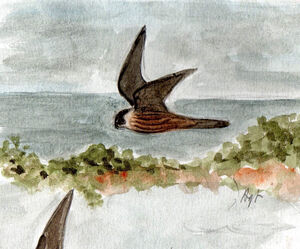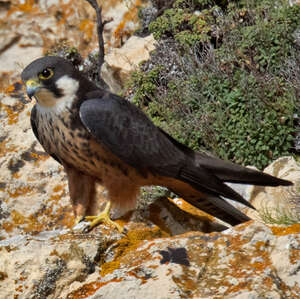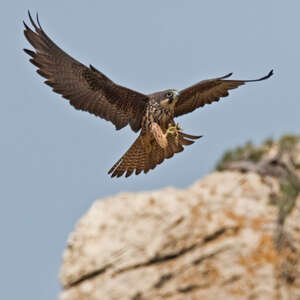Eleonora's Falcon
Falco eleonorae - Faucon d'Éléonore
Identification
Eleonora's Falcon is a medium-sized falcon, a little stockier than the Hobby. It has long, narrow wings and a long tail, giving it a particular silhouette that differentiates it from the Hobby. Both sexes are similar, with the female simply larger than the male.
There are two different morphs, light and dark.
The light morph (most common) has all the upper parts a rather dark slate grey, with blackish remiges. The background colour of the underside of the body ranges from white (at the throat) to quite intense rufous on the belly, under-tail coverts and flanks, in a regular gradient. The chest and belly are streaked longwise with blackish. The grey tail is noticeably barred. Compared with the Hobby, the rufous colour is more extensive and less vivid, and the chest less white. The best identification criterion remains the contrast under the wings between the dark under-wing coverts and the non-barred grey remiges. The white cheek patch is round in shape (heart-shaped in the Hobby). The wax of the beak and eye-ring are steel blue in adult female and immature. The iris is dark brown.
The dark morph (about 1 in 5 individuals) is entirely dark brown, appearing black from a distance. The underside of the wing has the same contrast as in the light morph.
The juvenile has no rufous underside and can be confusing. Care must be taken to the silhouette and proportions. The beak, wax and eye-ring are steel blue. The underwing contrast, less clear-cut, is still perceptible, allowing it to be differentiated from a young Hobby, especially as the remiges are barred in the same way. Immature individuals are intermediate.
Subspecific information monotypic species
Foreign names
- Faucon d'Éléonore,
- Halcón de Eleonora,
- falcão-da-rainha,
- Eleonorenfalke,
- Eleonóra-sólyom,
- Eleonora's Valk,
- Falco della Regina,
- eleonorafalk,
- Eleonorafalk,
- sokol ostrovný,
- ostříž jižní,
- Eleonorafalk,
- välimerenhaukka,
- Eleonoravalk,
- falcó de la reina,
- Eyfálki,
- sokół skalny,
- Eleonoras piekūns,
- sredozemski sokol,
- Сокол Элеоноры,
- エレオノラハヤブサ,
- 艾氏隼,
- eleonorafalk,
- 埃歐諾拉氏隼,
Voice song and call
Habitat
Eleonora's Falcon loves rocky islands and coastal cliffs for breeding. On migration, it happily stops in wet areas, valleys with water courses surrounded by riparian vegetation and bounded by reliefs causing aerial and thermal movements and determining migration corridors for small passerines that it hunts. It happily perches atop dominant trees which serve as lookout points. In winter, open forests and woodlands are added.
Behaviour character trait
Eleonora's Falcon is a great migrant. The birds travel long distances in small, single- or multi-species groups.
Breeding is colonial. At the time of settling, the falcons make their nuptial parade in noisy groups in which the couples cannot be distinguished. At first suspended in the air, they plunge into a vertiginous dive towards the sea. It is not uncommon to see, as the male approaches, the female roll over on her back presenting her claws, without the two partners touching.When hunting, they do a gliding scouting flight before diving on the detected prey. Occasionally, when conditions allow, they use a very particular hunting mode. They form a tight front at dawn and at high altitude, waiting for the arrival of birds, their main prey. They then launch themselves on them, tie them in flight and take them directly to the nest and then repeat the same process as long as the passage lasts. Eleonora's Falcon is willingly crepuscular, which means it can also take advantage of the edges of the migration of nocturnal passerine migrants. During the breeding period, it's the males who are responsible for providing food.
Geographic range
The distribution range mainly concerns the countries bordering the Mediterranean Sea (mainly Maghreb, Balearic Islands, Greece, Turkey and Cyprus), but also extends to the Atlantic coast of Morocco and as far as the Canary Islands. The wintering range, very distant, mainly covers Madagascar and occasionally neighbouring African continent (Mozambique). The migration mainly takes place through the eastern part of the African continent. Spring overflights are frequently observed in Europe to the northwest of the range, particularly in France.
Threats - protection
IUCN conservation status
concern
in the Wild
threatened
evaluated
Sources of information
- IOC World Bird List (v15.1), Gill, F and D Donsker (Eds). 2025-12-07.
- Guide des rapaces diurnes : Europe, Afrique du Nord et Moyen-Orient, Benny Gensbol
- Les rapaces diurnes et nocturnes d'Europe, M. Cuisin, P. Geroudet
- HBW Alive,
Other sources of interest
 Specification sheet created on
25/07/2023 by Jean François
Specification sheet created on
25/07/2023 by Jean FrançoisTranslation by AI Oiseaux.net
© 1996-2026 Oiseaux.net
- Accipitriformes
- Aegotheliformes
- Anseriformes
- Apodiformes
- Apterygiformes
- Bucerotiformes
- Caprimulgiformes
- Cariamiformes
- Casuariiformes
- Charadriiformes
- Ciconiiformes
- Coliiformes
- Columbiformes
- Coraciiformes
- Cuculiformes
- Eurypygiformes
- Falconiformes
- Galliformes
- Gaviiformes
- Gruiformes
- Leptosomiformes
- Mesitornithiformes
- Musophagiformes
- Nyctibiiformes
- Opisthocomiformes
- Otidiformes
- Passeriformes
- Pelecaniformes
- Phaethontiformes
- Phoenicopteriformes
- Piciformes
- Podargiformes
- Podicipediformes
- Procellariiformes
- Psittaciformes
- Pterocliformes
- Rheiformes
- Sphenisciformes
- Steatornithiformes
- Strigiformes
- Struthioniformes
- Suliformes
- Tinamiformes
- Trogoniformes




























